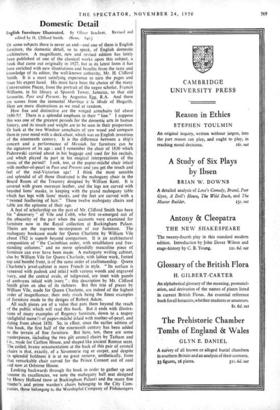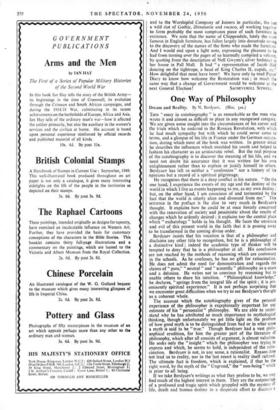Domestic Detail
English Furniture Illustrated. By Oliver Brackett. Revised and edited by H. Clifford Smith. (Benn. 80.) ' OF some subjects there is never an end—and one of them is English furniture, the domestic detail, so to speak, of English domestic architecture. A magnificent, new and revised edition has lately been published of one of the classical works upon this subject, a book that came out originally in 1927, but in its latest form it has been enriched with new illustrations and benefits from the taste and knowledge of its editor, the well-known authority, Mr. H. Clifford Smith. It is a most satisfying experience to turn the pages and trace his expert hand. His must have been the choice of the many Conversation Pieces, from the portrait of the negro scholar, Francis Williams, in his library at Spanish Tower, Jamaica, to that old favourite, Past and Present. by Augustus Egg, RA. And there are scenes from the immortal Marriage it la Mode of Hogarth. Here are more illustrations as we read at random.
How fine and distinctive are the winged armchairs (of about 1680-5)! There is a splendid emphasis in their "line." I suppose this was one of the greatest periods for the domestic arts in human history, and its touch and weight are to be seen in their proportion. Or look at the two Windsor armchairs of yew wood and compare them in your mind with a deck-chair, which was an English invention of the nineteenth century. It is the difference between a ship's concert and a performance of Messiah, for furniture can be the signature of its age ; and I remember the chair of 1830 which Paderewski carried about in his baggage and used for his recitals, and which played its part in his magical interpretations of the music of the period! Look, too, at the papier-mache chair inlaid with mother-of-pearl in Past and Present and you get the touch and feel of the mid-Victorian age! I think the most sensible and splendid of all those illustrated is the mahogany chair in the Board Room of the Treasury designed by William Kent. It is covered with green morocco leather, and the legs are carved with bearded lions' masks, in keeping with the grand mahogany table which has legs with lions' masks, and the feet are carved with a "twisted feathering of hair." Those twelve mahogany chairs and table are the epitome of their age.
A feat of scholarship on the part of Mr. Clifford Smith has been his " discovery " of Vile and Cobb, who first re-emerged out of the obscurity of the past when the accounts were examined for furniture now in the Royal collection at Buckingham Palace. Theirs are the supreme masterpieces of our furniture. The mahogany bookcase made for Queen Charlotte by William Vile about 1762 is superb beyond comparison. It is an architectural composition of "the Corinthian order, with entablature and free- standing columns," and no more splendidly masculine piece of furniture can ever have been made. A mahogany writing cabinet, also by William Vile for Queen Charlotte, with lattice work, fretted top and bombe front, is of the same order of craftsmanship. Queen Charlotte's jewel-cabinet is more French in style. "Its surface is veneered with padouk and inlaid with various woods and engraved ivory„ and the central ovals, of tulipwood, are inset with panels of amboyna 'inlaid with ivory " ; this description by Mr. Clifford Smith gives an idea of its richness. But this trio of pieces by William Vile, made for Queen Charlotte, are indeed of the highest order of magnificence, their only rivals being the finest examples of furniture made to the designs of Robert Adam. Al! such pieces are of a value that puts them beyond the reach of the public' which will read this book. But it ends with illustra- tions of Marty examples of Regency furniture, down to a teapoy (delightful name!) of papier-mâché inlaid with mother-of-pearl, and dating from about 1850. So, in effect, since the earlier edition of this book, the first half of the nineteenth century has been added to the terrain of fine furniture. But here, too, there are some masterpieces, including the two gilt council chairs by Tatham and Co., made for Carlton House, and shaped like ancient Roman seats. The coiled, brassy ornamentation at the back of this pair of council chairs is that, exactly, of a Savonnerie rug or carpet, and despite its splendid boldness it is at no great remove, aesthetically, from that remarkable chair carved for the Prince Consort out of coal and now at Osborne House. Looking backwards through the book in order to gather up and resume its excellencies, we note the mahogany hall seat designed by Henry Holland (now at Buckingham Palace) and the many fine master's and prime warden's chairs belonging to the City Com- panies, those belonging IG the Worshipful Company of Fishmongers and to the Worshipful Company of Joiners in particular, the last a wild riot of Gothic, thinoiserie and rococo, all working together to form probably the most sumptuous piece of such furniture In 'existence. We note that the name of Chippendale, lately the most famous in English furniture, has fallen largely into desuetude owing to the discovery of the names of the firms who made the furniture. And I would end upon a light note, expressing the pleasure to be had from turning over the pages of so learnedly compiled a volume, by quoting from the description of Nell Gwynn's silver bedstead in her house in Pall Mall. It had "a representation of Jacob Hall dancing on the tightrope, a head of King Charles II, cupids, etc." How delightful that must have been! We have only to read. Pep' Diary to know how welcome the Restoration was ; in much the same way that a change of Government would be welcome at the















































































 Previous page
Previous page